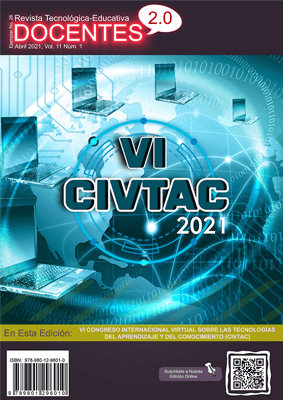Inclusive Education and ICT: Assistive Technologies for People with Sensory Disabilities
 DOI:
https://doi.org/10.37843/rted.v11i1.204
DOI:
https://doi.org/10.37843/rted.v11i1.204
Main Article Content
Abstract
The use of technology within the educational space plays a vital role in developing innovative teaching materials or resources. Despite the significant changes that technology has with it, it is possible to question the fiscal, educational institutions of the Ecuadorian Ministry of Education, where the lack of knowledge regarding the use of digital educational resources in the inclusion of people with sensory disabilities is still evident. Thus, this research originated the integration of ICT information and communication technologies as a didactic resource in the communication and teaching-learning processes generated in the educational community. The research process used the mixed approach, where 35 teachers from different educational institutions participated, who were applied as instruments based on the LIKERT scale survey, an-interview, and direct observation and bibliographic review. A diversity of technological resources that can use in educational inclusion processes was evidenced among the results obtained. We can mention digital pictograms, infographics, and mobile applications, strengthening the communication and teaching-learning process of the academic community. Consequently, it can assert that incorporating technologies in educational communities supports the teaching-learning operations and makes the educational inclusion processes more widespread.
Downloads
Metrics
Article Details

This work is licensed under a Creative Commons Attribution-NonCommercial-NoDerivatives 4.0 International License.
Those authors who have publications in our journal accept the following terms:
- When a work is accepted for publication, the author retains rights of reproduction, distribution of his/her article for exploitation in all countries of the world in the format provided by our magazine and any other magnetic medium, optical, and digital.
- Authors will retain their copyright and guarantee the journal the right first to publish their work, which will be simultaneously subject to the Creative Commons Acknowledgment License (Attribution-NonCommercial-NoDerivatives 4.0 International (CC BY-NC-ND 4.0)). That allows third parties to copy and redistribute the material in any medium or format, under the following conditions: Acknowledgment - You must properly acknowledge authorship, provide a link to the license, and indicate if any changes have been made. You may do so in any reasonable way, but not in a way that suggests you have the licensor's endorsement or receive it for your use. NonCommercial - You may not use the material for a commercial purpose. NoDerivatives - If you remix, transform, or build from the material, you cannot broadcast the modified material. There are no additional restrictions - You cannot apply legal terms or technological measures that legally restrict you from doing what the license allows.
- Authors may adopt other non-exclusive license agreements to distribute the published version of the work (e.g., deposit it in an institutional archive or publish it in a monographic volume) provided that the initial publication in this journal is indicated.
- Authors are allowed and recommended to disseminate their work through the Internet (e.g., in institutional telematic archives, repositories, libraries, or their website), producing exciting exchanges and increasing the published work's citations.
- Request of withdrawal an article has to be done in writing by the author to the Editor, becoming effective after a written response from the Editor. For this purpose, the author or authors will send correspondence via e-mail: [email protected].
- The author will not receive financial compensation for the publication of his work.
- All Docentes 2.0 Journal publications are under the Open Journal System (OJS) platform at: https://ojs.docentes20.com/.
References
Acosta, M., Betún, A., Delgado, J., & Iñiguez, M. (2020). Las TIC como oportunidad para fortalecer el PEA en los estudiantes con discapacidad visual. Revista Tecnológica-Educativa Docentes 2.0, 9(1), 42-48. https://doi.org/10.37843/rted.v9i1.97 DOI: https://doi.org/10.37843/rted.v9i1.97
Cabero-Almenara, J., & Ruiz Palmero, J. (2017). Las Tecnologías de la Información y Comunicación para la inclusión: reformulando la brecha digital. Ijeri. International Journal of Educational Research and Innovation, 9, 16-30.
Castillo, R. G. (2020). La educación inclusiva. Análisis y reflexiones en la educación superior ecuatoriana. Scielo, 15(1), 2 - 12 ISSN: 1390 - 8642. http://scielo.senescyt.gob.ec/pdf/alteridad/v15n1/1390-325Xalteridad-15-01-00113.pdf
CONADIS. (2020). Estadísticas de Discapacidad –Consejo Nacional para la Igualdad de Discapacidades. https://www.consejodiscapacidades.gob.ec/estadisticas-de-discapacidad/
Guaicha, K. Delgado, J.C., Coello, A., Rivera, A., Yaure, A., & Quevedo, H. (2020). Uso de pictogramas digitales como estrategia de enseñanza para fortalecer el proceso de lectura de estudiantes de educación general básica, Actas EDULEARN20, 4199-4204.
Luque, D. J., & Luque, M. J. (2013). Necesidades Específicas de Apoyo Educativo del alumnado con discapacidades sensorial y motora. https://dialnet.unirioja.es/descarga/articulo/4703039.pdf
Eitel, S. T., & Ramírez-Burgos, M. J. (2016). Experiencia de inclusión en educación superior de estudiantes en situación de discapacidad sensorial. Educación y educadores, 19(1), 9-28. https://www.redalyc.org/pdf/834/83445564001.pdf DOI: https://doi.org/10.5294/edu.2016.19.1.1
López, F. R., Guelmes, V. E., Nieto, A. L., Cárdenas, C. L., Sánchez, G. S., & Montalván, S. M. (2017). Algunas reflexiones sobre el enfoque mixto: En el contexto cubano de la investigación pedagógica. Revista Estudios Pedagógicos Originales, 46-53
Luque-Parra, D. J. (2014). Las necesidades educativas especiales como necesidades básicas. Una reflexión sobre la inclusión educativa. http://www.repositoriocdpd.net:8080/bitstream/handle/123456789/329/Art_LuqueParraDJ_NecesidadesEducativasEspeciales_2009.pdf?sequence=1
Mujica-Sequera, R. (2020). La Enseñanza Tecnoemocional en la Educación del Siglo XXI. Revista Tecnológica-Educativa Docentes 2.0, 9(2), 71-78. https://doi.org/10.37843/rted.v9i2.147 DOI: https://doi.org/10.37843/rted.v9i2.147
Ramírez-Valbuena, W. Á. (2017). La inclusión: una historia de exclusión en el proceso de enseñanza-aprendizaje. SCIELO, 215,216. Obtenido de http://www.scielo.org.co/pdf/clin/n30/0121-053X-clin-30-00211.pdf DOI: https://doi.org/10.19053/0121053X.n30.0.6195
Sandoval, C. H. (2020). La Educación en Tiempo del Covid-19 Herramientas TIC: El Nuevo Rol Docente en el Fortalecimiento del Proceso Enseñanza Aprendizaje de las Prácticas Educativa Innovadoras. Revista Tecnológica-Educativa Docentes 2.0, 9(2), 24-31. https://doi.org/10.37843/rted.v9i2.138 DOI: https://doi.org/10.37843/rted.v9i2.138
Serrato, S. (2009). La discapacidad auditiva, ¿cómo es el niño sordo. Revista digital innovación y experiencias educativas, 1-10.
Tamayo, M. (2009). La discapacidad sensorial desde la perspectiva de un genetista. Medicina, 31(4), 238-245. http://revistamedicina.net/ojsanm/index.php/Medicina/article/view/87-3/309
Tuset, P. (2011). Messenger Visual, a pictogram-based Instant Messaging service for individuals with cognitive disability. Proyecto fin de carrera. Universitat Politécnica de Catalunya. https://upcommons.upc.edu/bitstream/handle/2099.1/11290/memoria.pdf
Zappalá, D. Köppel, A., & Suchodolski, M. (2019). Inclusión de tic en escuelas para alumnos con discapacidad visual. Ministerio de Educación de la Nación Argentina.






